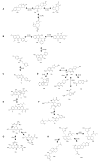Novel chemical space exploration via natural products
- PMID: 19265440
- PMCID: PMC2696019
- DOI: 10.1021/jm801514w
Novel chemical space exploration via natural products
Abstract
Natural products (NPs) are a rich source of novel compound classes and new drugs. In the present study we have used the chemical space navigation tool ChemGPS-NP to evaluate the chemical space occupancy by NPs and bioactive medicinal chemistry compounds from the database WOMBAT. The two sets differ notably in coverage of chemical space, and tangible leadlike NPs were found to cover regions of chemical space that lack representation in WOMBAT. Property based similarity calculations were performed to identify NP neighbors of approved drugs. Several of the NPs revealed by this method were confirmed to exhibit the same activity as their drug neighbors. The identification of leads from a NP starting point may prove a useful strategy for drug discovery in the search for novel leads with unique properties.
Figures





References
-
- Adams D. The hitch-hiker’s guide to the galaxy. Pan Books; London: 1979.
-
- Bohacek RS, McMartin C, Guida WC. The art and practice of structure-based drug design: a molecular modeling perspective. Med Res Rev. 1996;16:3–50. - PubMed
-
- Cragg GM, Newman DJ, Snader KM. Natural products in drug discovery and development. J Nat Prod. 1997;60:52–60. - PubMed
Publication types
MeSH terms
Substances
Grants and funding
LinkOut - more resources
Full Text Sources
Medical
Miscellaneous

